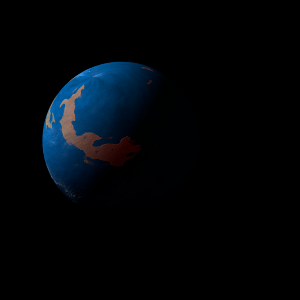|
|
Space Astro
|
Info for exoplanet "Oraba"
| Scientific (actual) data |
|---|
| Name | Kepler-647 c |
| Planet status | Confirmed |
| Radius | 0.357 |
| Orbital period | 29.6663 |
| Discovered | 2020 |
| Updated | 2021-02-05 |
| Publication | Published in a refereed paper |
| Detection type | Primary Transit |
| Alternate names | 2MASS J18590919+4435300 c, K00691.01, KIC 8480285 c, KOI-691 c, KOI-691.01, WISE J185909.19+443529.8 c |
| Star name | Kepler-647 |
| Right ascension | 284.79° |
| Declination | 44.59° |
| Mag j | 12.898 |
| Mag h | 12.585 |
| Mag k | 12.611 |
| Star distance | 789 |
| Star metallicity | -0.14 |
| Star mass | 1.03 |
| Star radius | 1.07 |
| Star age | 4.27 |
| Star temperature | 6020 |
| Star alternate names | 2MASS J18590919+4435300, KIC 8480285, KOI-691, WISE J185909.19+443529.8 |
| Wikipedia article | Kepler-647 c |
Back
| |
| Fictional info (?) |
|---|
| Suggested name | Oraba |
| Planet type | Cold planet |
|
The surface is crowded with aggressive primordial carnivores known to spend their life while consuming a substance called "Zumegi". Most Pamakigyo are related to the Sotopa So, have scales and vary in length from 60 to 120 mm. They can endure temperatures from -60 to -50°C and even even a limited degree of radiation which is common on Oraba. |
| Estimated population | 21000000000 |
| Atmosphere | Methane | 82% |
| Water | 15% |
| Carbon dioxide | 2.1% |
| Oxygen | 0.38% |
| Atmospheric pressure | 80 bar |
 |
| Moon | Gyuzesho Ze | Small round gaseous planetoid |
| Neshinu-wo | Medium-sized round oceanic comet |
| Mogeno-pyaryo | Large slightly egg-shaped gaseous asteroid |
| Robashi'yu | Medium-sized irregular rocky comet |
| Shinami-zaryakyo | Large round gaseous asteroid |
| Gyoga Heze | Medium-sized potato shaped rocky moon |
| Wawakujo Wabeju | Huge irregular gaseous planetoid |
| Hyome'chagyu Pe | Small potato shaped crater-filled planetoid |
| Chopya Pyoshi | Huge irregular ice moon |
| Hyope'myu | Small potato shaped rocky asteroid |
| Hyumu Nori-ra | Medium-sized irregular rocky asteroid |
| Nobyu Nu | Medium-sized round ice asteroid |
| Koekya-pogyu | Medium-sized almost round gaseous moon |
| Myohyo Gupyukyo | Medium-sized potato shaped oceanic moon |
| Pichija Hyushonu | Medium-sized irregular oceanic moon |
| Hyafu Tobya | Very small potato shaped gaseous moon |
| Pimyu Bo | Small round gaseous asteroid |
| Shuchi | Large irregular crater-filled comet |
| Daworeshu | Huge potato shaped oceanic moon |
| Pyuyu | Huge slightly egg-shaped crater-filled moon |
| Nyosha | Large potato shaped gaseous planetoid |
| Google search for Oraba |
|
Website by Joachim Michaelis
|
|
|
|